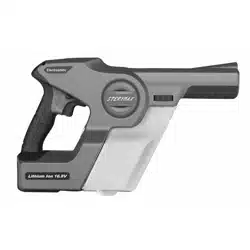Loading ...
Loading ...
Loading ...

STX-360ES SAFETY INSTRUCTIONS
5
components run water through the sprayer for 3 minutes.
Important Safety Instructions for Battery Packs
Your cordless sprayer uses a 16.8 volt Lithium Ion battery pack. The battery pack is not fully
charged out of the carton. Before using the battery pack and charger, read the safety
instructions below. Then follow charging procedures outlined.
CAUTION: The battery used in this device may present a risk of fire or chemical burn if
mistreated. Do not disassemble, store in extreme heat or cold.
Keep away from children. Do not disassemble. Do not dispose of in fire.
Do not attempt to disassemble the battery or remove any component projecting from the
battery terminals. The battery and charger have no user serviceable parts. Fire or injury may
result from tampering prior to disposal, protect exposed terminals with heavy insulating tape to
prevent shorting.
DANGER: Electrocution hazard. Never attempt to open the battery pack for any reason. If
battery pack case is cracked or damaged, do not insert into charger. Electric shock or
electrocution may result.
WARNING: Fire hazard. Do not store or carry battery so that metal objects can contact
exposed battery terminals. For example, do not place battery in aprons, pockets, toolboxes,
product kit boxes, drawers, etc., with loose nails, screws, keys, etc.
CAUTION: Battery pack must be securely attached to the cordless sprayer. If battery pack is
detached, personal injury may result.
Do not incinerate the battery pack even if it is severely damaged or is completely worn out. The
battery pack can explode in a fire.
Charge the battery packs only with the original charger.
DO NOT splash or immerse in water or other liquids.
Do not store or use the tool and battery pack in locations where the temperature may reach or
exceed 105°F (40 )! (such as outside sheds or metal buildings in summer).
Damaged battery packs should be recycled.
Transporting batteries can possibly cause fires if the battery terminals inadvertently come in
contact with conductive materials such as keys, coins, hand tools and the like.
The US Department of Transportation Hazardous Material Regulations (HMR) prohibits
transporting batteries in commerce or on airplanes (i.e., packed in suitcases and carry-on
luggage) UNLESS they are properly protected from short circuits. When transporting individual
batteries, make sure that the battery terminals are protected and well insulated from materials
that could contact them and cause a short circuit.
Important Safety Instructions for Battery Chargers
SAVE THESE INSTRUCTIONS: This manual contains important safety instructions for battery
chargers. Before using charger, read all instructions and cautionary markings on charger,
battery pack, and product using battery pack.
DANGER: Electrocution hazard. 120 volts are present at charging terminals. Do not probe with
conductive objects.
WARNING: Shock hazard. Do not allow any liquid to get inside charger.
CAUTION: Burn hazard. To reduce the risk of injury, charge only Whynter Innovations
rechargeable batteries. Other types of batteries may burst causing personal injury and damage.
Loading ...
Loading ...
Loading ...
